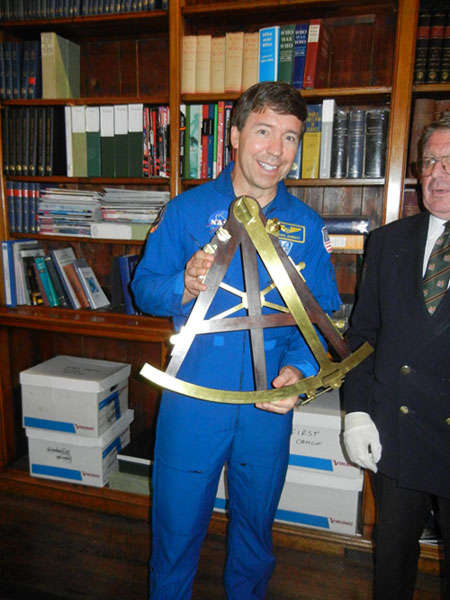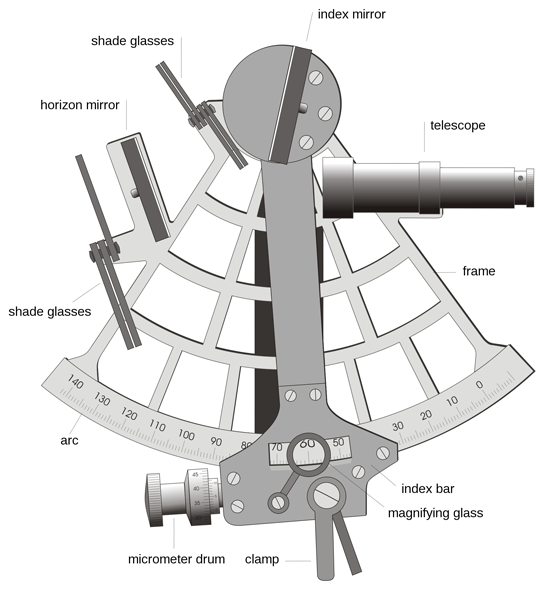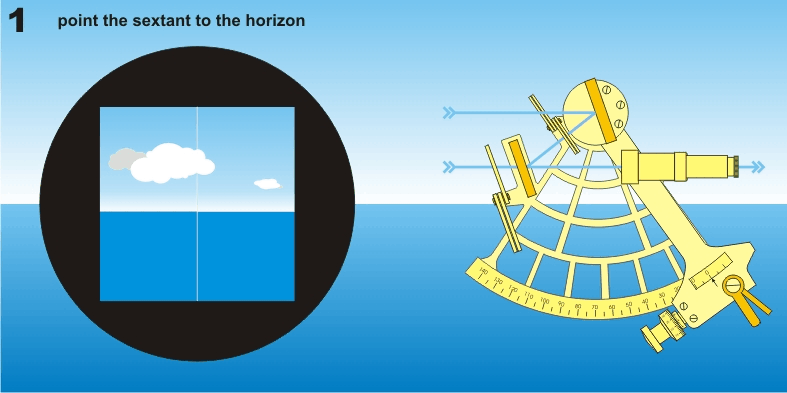The Vanishing Sextant
Today, the Vanishing Sextant. The University of Houston presents this series about the machines that make our civilization run, and the people whose ingenuity created them.

Here I am holding a sextant that belonged to Captain James Cook. The blue suit is due to the nature of the occasion; my crew of the Space Shuttle Discovery (STS-133) was paying an official visit to the Royal Astronomical Society. Because I was introduced as a bit of a nautical history nut, the curator fished out this beautiful sextant and carefully handed it to me. I was less nervous holding my first newborn baby.
During a recent visit to the Royal Astronomical Society in London, I had a chance to hold a sextant that once belonged to Captain James Cook. Never mind that it didn't actually go with him on any of his voyages — here was an artifact connecting me to one of the great explorers and navigators of all time. No single object is so iconic of ocean voyaging and navigation as the sextant, and this was a beauty! Beyond that, the sextant occupies an interesting place in the evolution of navigation.
Finding latitude, the line on the earth north or south of the equator, requires measuring the angle between the horizon and a known object, such as the north star, Polaris. This has been known by mariners for at least a couple thousand years. Measuring this angle required the navigator to sight two objects, say Polaris and the horizon, simultaneously. This could be done crudely with outstretched arm and fingers, or with straight sticks held at a common distance from the eye. Difficult enough on land, much more so on a pitching, rolling deck. The less accurate you were the less confident of your position on a chart and the more extra distance you might go.
I vastly simplify a fascinating history by noting that many devices were developed over centuries to improve this measurement, such as the quadrant, the astrolabe, and the cross staff. A breakthrough came in the early 18th century, nearly simultaneously by Englishman John Hadley and American Thomas Godfrey. Each discovered that using two mirrors, a celestial object's image could be reflected onto the same plane as the horizon being sighted by the viewer. Adjusting the arm of the mirror sighting the star to bring its image level with the horizon, one could read the angle between the two against a scale on an arc. With this reflected optics scheme, measurements over one quarter of the sky, or 90 degrees, could be made using an arc of one eighth of a circle. This device became known as the mariner's octant. To measure objects greater than 90 degrees above the horizon, the arc was expanded to one sixth of a circle, from which we get the word sextant.
The sextant reached its mature form by the mid 18th century and has remained basically unchanged since that time. Over the last few decades, celestial navigation has been largely displaced by long range radio navigation and the satellite based global positioning system, or GPS. Unlike the skill intensive practice of celestial navigation, very little understanding of the GPS system is required of the user. Any of us are just a button push and a few seconds away from determining our exact position. Many of us have phones that can do this.

A diagram showing the basic parts of a modern sextant. Again the real breakthrough is in the observer only having to site in one direction, bringing the two objects being measured into the same visual plane. A fine scale, micrometer adjustment, and optics allow very precise measurements of the angle between the two objects. From the Wikimedia Commons by Joaquim Alves Gaspar.
And so we can lament the fading of a beautiful instrument with a romantic image — it's doubtful that the silhouette of a GPS box will grace a travel documentary or adventure novel. But we can celebrate the sextant as the symbol of applied celestial navigation, the jumping off point from which one superbly matured technology was superseded by another. And as wind and sails remain to drive a ship should we decide to avail them, so the sun, moon, and stars await our need to find our way. It is only a matter of what means we use to read them.
I'm NASA astronaut Michael Barratt for the University of Houston, where we're interested in the way inventive minds work.
(Theme music)
Navigation on the earth's surface is all about the measurement of angles and time. As noted in the episode, the concept of determining latitude, the angular distance on the earth north or south of the equator, has been understood by mariners for a very long time. Polaris, steady in its position marking practical true north, should be considered a gift to travelers and emerging seafaring peoples. In the northern hemisphere where Polaris is visible, measuring the angle between it and the horizon basically gives you your latitude. If this angle is 90 degrees, Polaris is straight up and you're at the North Pole, latitude 90. If zero, Polaris is right on the horizon and you're at the equator. European mariners outbound to the new world could measure and record the latitudes of home ports or other desired destinations based on these sightings. On a return Atlantic crossing, they could sail north or south until the reference latitude was reached, then sail down this latitude until they reached home. Although you were fairly assured of eventually finding your way home, you might sail many extra miles, especially if your measurements were rough and inconsistent. Improving the accuracy of these measurements was vital, driving the development of devices that were precise and less dependent on operator technique and skill. Short of GPS and electronic star trackers, the sextant was the inevitable outcome.

A nifty little animation clip showing how the sextant brings two images at different angles from the observer into the same plane to allow precise measurement of the angle between them. From the Wikimedia Commons.
Of course latitude isn't the whole story, and even that became tricky if you couldn't see your main northern reference point. In the southern hemisphere, Polaris is not visible, but other celestial bodies, including the sun and moon, could be sighted and their angular measurement from the horizon used if you could account for their position change for the time of the year and time of day. Prince Henry the Navigator pioneered the methodical use of observations of other sky objects corrected for seasonal variation in the 15th century for his Portuguese sailors. Over the ensuing centuries, extensive astronomical tables were crafted to predict the position of celestial bodies at more exact times of the observations. These were needed to provide what was really missing from the navigational equation, that being accurate determination of longitude, the angular distance east or west of a reference meridian. The solution to this was all about time.
The prevailing data base of the 18th through 20th centuries was developed and maintained by the Royal Greenwich Observatory in England at zero degrees longitude, aptly known as the Prime Meridian. As such, observations taken at sea had to be further referenced to these data to account for the time difference between Greenwich and where on the globe the observation was taken. This required the use of an accurate sea-going clock referenced to the point on the globe where those observations were taken. Precision measurements of time and the needed celestial angles translated to precision navigation, allowing in turn the accurate surveying of land masses and crafting of nautical charts. James Cook was equipped with the latest technology in angular measurements — octants and sextants — as well as the state of the art seagoing clock of the time, and did a masterful job surveying the many lands he visited. Some of Captain Cook's charts were sufficiently accurate that they were used up into the 20th century.
There is of course so much more to celestial navigation than in this discussion centered on the sextant. Although these techniques are being less frequently taught for military use and commercial shipping, there will certainly remain a cadre of practitioners who see this as a time honored method that is independent of the proper functioning of onboard electronics.
References:
The internet remains a terrific playground for information seekers, and the Wikipedia treatise on Celestial Navigation is quite good — certainly easier reading than my dusty old copy of Dutton's Navigation and Piloting. However I would recommend a really nice discussion on the History of the Sextant by Professor Peter Ifland, given as a lecture at the Science Museum of the University of Coimbra in 2000. It is told as if by someone relating a cherished story. Here's the link: http://www.mat.uc.pt/~helios/Mestre/Novemb00/H61iflan.htm
This episode first aired on August 7, 2013.